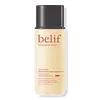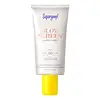Belif Super Drops Niacinamide Golden Glow Serum Versus Supergoop! Glowscreen Hydrating And Glowing Sunscreen Primer SPF 30
What's inside
What's inside
 Key Ingredients
Key Ingredients

 Benefits
Benefits

 Concerns
Concerns

 Ingredients Side-by-side
Ingredients Side-by-side

Water
Skin ConditioningDimethicone
EmollientMethyl Trimethicone
Skin ConditioningCetyl Ethylhexanoate
EmollientHdi/Trimethylol Hexyllactone Crosspolymer
2,3-Butanediol
HumectantAlcohol Denat.
AntimicrobialGlycerin
HumectantIsododecane
EmollientSynthetic Fluorphlogopite
Niacinamide
SmoothingPEG-10 Dimethicone
Skin ConditioningCetyl PEG/PPG-10/1 Dimethicone
EmulsifyingDimethicone/PEG-10/15 Crosspolymer
1,2-Hexanediol
Skin ConditioningPanthenol
Skin ConditioningMelissa Officinalis Flower/Leaf/Stem Water
Skin ConditioningRosmarinus Officinalis Leaf Water
MaskingThymus Vulgaris Leaf Extract
Skin ProtectingEucalyptus Globulus Leaf Extract
PerfumingMentha Rotundifolia Leaf Extract
TonicRosa Canina Fruit Extract
AstringentBetaine
HumectantSodium Gluconate
Skin ConditioningGluconolactone
Skin ConditioningPhytosterols
Skin ConditioningSqualane
EmollientAscorbic Acid
AntioxidantHydrogenated Lecithin
EmulsifyingCeramide NP
Skin ConditioningCeramide Ns
Skin ConditioningCholesterol
EmollientPhytosphingosine
Skin ConditioningCeramide AP
Skin ConditioningCeramide As
Skin ConditioningCeramide EOP
Skin ConditioningDisteardimonium Hectorite
StabilisingMagnesium Sulfate
Distearyldimonium Chloride
Palmitic Acid
EmollientSilica
AbrasiveTocopheryl Acetate
AntioxidantStearic Acid
CleansingDipropylene Glycol
HumectantTin Oxide
AbrasiveSodium Citrate
BufferingTocopherol
AntioxidantPentaerythrityl Tetra-Di-T-Butyl Hydroxyhydrocinnamate
AntioxidantCetearyl Alcohol
EmollientCitrus Aurantium Dulcis Peel Oil
MaskingCitrus Aurantifolia Oil
CleansingPelargonium Graveolens Flower Oil
MaskingRosmarinus Officinalis Leaf Oil
MaskingLimonene
PerfumingCitronellol
PerfumingGeraniol
PerfumingCitral
PerfumingLinalool
PerfumingCI 77891
Cosmetic ColorantCI 77491
Cosmetic ColorantWater, Dimethicone, Methyl Trimethicone, Cetyl Ethylhexanoate, Hdi/Trimethylol Hexyllactone Crosspolymer, 2,3-Butanediol, Alcohol Denat., Glycerin, Isododecane, Synthetic Fluorphlogopite, Niacinamide, PEG-10 Dimethicone, Cetyl PEG/PPG-10/1 Dimethicone, Dimethicone/PEG-10/15 Crosspolymer, 1,2-Hexanediol, Panthenol, Melissa Officinalis Flower/Leaf/Stem Water, Rosmarinus Officinalis Leaf Water, Thymus Vulgaris Leaf Extract, Eucalyptus Globulus Leaf Extract, Mentha Rotundifolia Leaf Extract, Rosa Canina Fruit Extract, Betaine, Sodium Gluconate, Gluconolactone, Phytosterols, Squalane, Ascorbic Acid, Hydrogenated Lecithin, Ceramide NP, Ceramide Ns, Cholesterol, Phytosphingosine, Ceramide AP, Ceramide As, Ceramide EOP, Disteardimonium Hectorite, Magnesium Sulfate, Distearyldimonium Chloride, Palmitic Acid, Silica, Tocopheryl Acetate, Stearic Acid, Dipropylene Glycol, Tin Oxide, Sodium Citrate, Tocopherol, Pentaerythrityl Tetra-Di-T-Butyl Hydroxyhydrocinnamate, Cetearyl Alcohol, Citrus Aurantium Dulcis Peel Oil, Citrus Aurantifolia Oil, Pelargonium Graveolens Flower Oil, Rosmarinus Officinalis Leaf Oil, Limonene, Citronellol, Geraniol, Citral, Linalool, CI 77891, CI 77491
Water
Skin ConditioningOctocrylene
UV AbsorberButyloctyl Salicylate
Skin ConditioningEthylhexyl Salicylate
UV AbsorberPropanediol
SolventHomosalate
Skin ConditioningGlycerin
HumectantButyl Methoxydibenzoylmethane
UV AbsorberC12-15 Alkyl Benzoate
AntimicrobialGlyceryl Stearate Citrate
EmollientIsododecane
EmollientNiacinamide
SmoothingPolymethylsilsesquioxane
CI 77163
Cosmetic ColorantMica
Cosmetic ColorantCI 77891
Cosmetic ColorantCaprylic/Capric Triglyceride
MaskingCetyl Phosphate
EmulsifyingLeuconostoc/Radish Root Ferment Filtrate
AntimicrobialLimonium Gerberi Extract
Skin ProtectingPantothenic Acid
Skin ConditioningPhospholipids
Skin ConditioningSodium Hyaluronate
HumectantTheobroma Cacao Seed Extract
AntioxidantTocopherol
AntioxidantTrisodium Ethylenediamine Disuccinate
CI 77491
Cosmetic ColorantWater, Octocrylene, Butyloctyl Salicylate, Ethylhexyl Salicylate, Propanediol, Homosalate, Glycerin, Butyl Methoxydibenzoylmethane, C12-15 Alkyl Benzoate, Glyceryl Stearate Citrate, Isododecane, Niacinamide, Polymethylsilsesquioxane, CI 77163, Mica, CI 77891, Caprylic/Capric Triglyceride, Cetyl Phosphate, Leuconostoc/Radish Root Ferment Filtrate, Limonium Gerberi Extract, Pantothenic Acid, Phospholipids, Sodium Hyaluronate, Theobroma Cacao Seed Extract, Tocopherol, Trisodium Ethylenediamine Disuccinate, CI 77491
 Reviews
Reviews

Ingredients Explained
These ingredients are found in both products.
Ingredients higher up in an ingredient list are typically present in a larger amount.
Ci 77491 is also hydrated iron III oxide. It's sole purpose is to give a red/pink hue to products.
Iron III oxides are classified as inorganic chemicals for coloring.
Synthetically created Ci 77491 is considered safer than those naturally found. This is because the synthetically created version may contain less impurities. Iron oxides are generally non-toxic and non-allergenic.
Learn more about CI 77491Ci 77891 is a white pigment from Titanium dioxide. It is naturally found in minerals such as rutile and ilmenite.
It's main function is to add a white color to cosmetics. It can also be mixed with other colors to create different shades.
Ci 77891 is commonly found in sunscreens due to its ability to block UV rays.
Learn more about CI 77891Glycerin is already naturally found in your skin. It helps moisturize and protect your skin.
A study from 2016 found glycerin to be more effective as a humectant than AHAs and hyaluronic acid.
As a humectant, it helps the skin stay hydrated by pulling moisture to your skin. The low molecular weight of glycerin allows it to pull moisture into the deeper layers of your skin.
Hydrated skin improves your skin barrier; Your skin barrier helps protect against irritants and bacteria.
Glycerin has also been found to have antimicrobial and antiviral properties. Due to these properties, glycerin is often used in wound and burn treatments.
In cosmetics, glycerin is usually derived from plants such as soybean or palm. However, it can also be sourced from animals, such as tallow or animal fat.
This ingredient is organic, colorless, odorless, and non-toxic.
Glycerin is the name for this ingredient in American English. British English uses Glycerol/Glycerine.
Learn more about GlycerinIsododecane is a fragrance, emollient, and solvent.
As an emollient, it helps your skin stay soft and hydrated. Emollients help trap moisture into your skin.
Isododecane's role as a solvent makes it a great texture enhancer. It spreads smoothly on skin and does not leave a sticky feeling behind. Isododecane also helps prevent color transfer in makeup products.
Isododecane is not absorbed into skin.
Learn more about IsododecaneNiacinamide is a multitasking form of vitamin B3 that strengthens the skin barrier, reduces pores and dark spots, regulates oil, and improves signs of aging.
And the best part? It's gentle and well-tolerated by most skin types, including sensitive and reactive skin.
You might have heard of "niacin flush", or the reddening of skin that causes itchiness. Niacinamide has not been found to cause this.
In very rare cases, some individuals may not be able to tolerate niacinamide at all or experience an allergic reaction to it.
If you are experiencing flaking, irritation, and dryness with this ingredient, be sure to double check all your products as this ingredient can be found in all categories of skincare.
When incorporating niacinamide into your routine, look out for concentration amounts. Typically, 5% niacinamide provides benefits such as fading dark spots. However, if you have sensitive skin, it is better to begin with a smaller concentration.
When you apply niacinamide to your skin, your body converts it into nicotinamide adenine dinucleotide (NAD). NAD is an essential coenzyme that is already found in your cells as "fuel" and powers countless biological processes.
In your skin, NAD helps repair cell damage, produce new healthy cells, support collagen production, strengthen the skin barrier, and fight environmental stressors (like UV and pollution).
Our natural NAD levels start to decline with age, leading to slower skin repair, visible aging, and a weaker skin barrier. By providing your skin niacinamide, you're recharging your skin's NAD levels. This leads to stronger, healthier, and younger looking skin.
Another name for vitamin B3 is nicotinamide. This vitamin is water-soluble and our bodies don't store it. We obtain Vitamin B3 from either food or skincare. Meat, fish, wheat, yeast, and leafy greens contain vitamin B3.
The type of niacinamide used in skincare is synthetically created.
Learn more about NiacinamideTocopherol (also known as Vitamin E) is a common antioxidant used to help protect the skin from free-radicals and strengthen the skin barrier. It's also fat soluble - this means our skin is great at absorbing it.
Vitamin E also helps keep your natural skin lipids healthy. Your lipid skin barrier naturally consists of lipids, ceramides, and fatty acids. Vitamin E offers extra protection for your skin’s lipid barrier, keeping your skin healthy and nourished.
Another benefit is a bit of UV protection. Vitamin E helps reduce the damage caused by UVB rays. (It should not replace your sunscreen). Combining it with Vitamin C can decrease sunburned cells and hyperpigmentation after UV exposure.
You might have noticed Vitamin E + C often paired together. This is because it is great at stabilizing Vitamin C. Using the two together helps increase the effectiveness of both ingredients.
There are often claims that Vitamin E can reduce/prevent scarring, but these claims haven't been confirmed by scientific research.
Learn more about TocopherolWater. It's the most common cosmetic ingredient of all. You'll usually see it at the top of ingredient lists, meaning that it makes up the largest part of the product.
So why is it so popular? Water most often acts as a solvent - this means that it helps dissolve other ingredients into the formulation.
You'll also recognize water as that liquid we all need to stay alive. If you see this, drink a glass of water. Stay hydrated!
Learn more about Water